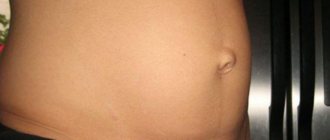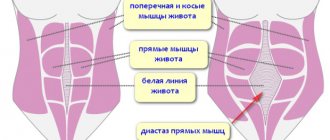Conception and pregnancy
Any implants are a foreign body inside the female body. This is precisely what many fears of women who want to have beautiful breasts are associated with. Objective data suggests that breast augmentation surgery does not in any way affect the process and likelihood of conception, or the pregnancy itself. Similar studies were conducted by scientists in several countries around the world. According to the results obtained, there is no statistical connection between the number of operations performed, as well as cases of decreased fertility (the ability to reproduce healthy offspring). Therefore, women who are not planning a pregnancy in the near future can safely decide to undergo the procedure.
During pregnancy, a woman's body changes rapidly. And this applies not only to hormonal levels, but also to immune reactions and metabolic processes even at the cellular level. However, the presence of implants in a woman’s body is in no way associated with the risk of miscarriage or the development of any congenital pathologies in the fetus. Silicone or polyurethane implants do not have a negative or positive effect on the unborn child.
Lactation period
During breastfeeding, implants also have no effect on either the mother’s well-being or the child’s comfort. As well as the quality of the milk itself. A few decades ago, there was an opinion that natural feeding was impossible after breast augmentation. However, today we know that this is not the case. Indeed, it is worth planning breast augmentation at least a year before the expected pregnancy, but only in order to give the body time to fully recover. In this case, no difficulties will arise in the future.
When going to see a doctor, it is worth warning the surgeon about your desire to become a mother in the near future. And although, with any access and method of installing implants, the mammary glands are not functionally affected, the ducts are not disturbed, and the woman will be able to fully feed her own breasts, the doctor can give advice that will help preserve the beautiful shape of the breasts as much as possible and avoid possible problems. As a result, all milk ducts and glands after the healing period will function exactly the same as before the operation. Accordingly, the lactation process will not be disrupted, and possible complications will be reduced to zero.
The exception in this case is extremely large prostheses. Excessively large implants can compress the gland itself and its ducts, interfere with the natural flow of blood and lymph in the tissues, which will negatively affect the breastfeeding process.
Is it possible to breastfeed with implants: doctors' opinion
Aesthetic medicine has come very far in our time. Technologies today are so developed that surgical intervention with further prosthetics can be combined with natural physiological processes.
Plastic surgeons say that there is no need to doubt whether it is possible to breastfeed after implants are installed . All over the world, thousands of mothers who have resorted to mammoplasty are feeding their babies. With breast implants, lactation is possible and completely safe.
The operation does not in any way affect the quality and quantity of milk. Even if the silicone implant is damaged, there is no danger. This filler is not able to be absorbed by body tissues, therefore, it cannot get into milk in any way. After all, even pacifiers for newborns are made from high-quality silicone, which does not affect the health and development of the child.
After childbirth
When making such a responsible decision, it should be taken into account that the breasts will definitely change after childbirth and feeding. It is almost impossible to predict its future appearance. However, experts note that heredity has a strong influence in this matter. Therefore, you can find out in advance from your closest relatives how their mammary glands have changed.
It has been noticed that in the presence of implants in the breast, the shape and size of the mammary glands after childbirth do not change as much as in women who have a completely natural, voluminous bust. But doctors advise not to forget that the condition of this part of the body, after such a difficult period for a woman, largely depends on competent and careful skin care, which will suffer regardless of the presence of implants. The less fluctuations in a woman’s weight, the more carefully she monitors her hormonal levels, the better her breasts will look after childbirth and breastfeeding.
When to have surgery
In resolving this issue, I advise experts to be guided by their own plans regarding the time of birth of children. The level of development of aesthetic and plastic surgery today is so high that you can safely enlarge your breasts, having plans to expand your family in the future. It is not at all necessary for a girl to give up her own plans to improve her body. Breast enlargement in no case excludes conception, full pregnancy, or lactation.
It is worth refusing breast augmentation if the birth of a child is planned in the near future, for example, within one year. This procedure is quite stressful for the body; the body needs to recover and adapt before pregnancy in order to adequately respond to the new load.
When making a decision, you should be guided by your own standards of beauty. You shouldn't expect your breasts to remain completely unchanged after pregnancy. Most often, the size increases further and the skin stretches. Sufficiently large implants have a significant weight and, accordingly, put additional pressure on the tissue, stretching the skin and ligaments. Therefore, it makes sense to limit ourselves to the small size of endoprostheses.
Breast surgery and breast augmentation are also associated with another procedure that many women require after lactation. Correction can be performed in conjunction with implant installation. An increase in the diameter of the areolas, a change in color, and their deformation are all not uncommon phenomena after childbirth and breastfeeding. This is another reason to postpone plastic surgery until after pregnancy.
After giving birth and breastfeeding, many women resort to plastic surgery, often combined: skin tightening, removal of excess tissue and increase in size, and installation of implants are performed simultaneously. This is a reasonable solution for those who are afraid of losing their original shape, especially with a corresponding tendency to stretch marks and loss of skin elasticity. Many doctors call this option preferable. From the point of view of performing the procedure, no additional difficulties arise after the birth of the child; for the surgeon, the task remains virtually unchanged, so you should not be afraid of any additional risks or complications and feel free to fulfill your desire to have beautiful breasts.
Correction of glands after childbirth, price - how much does such an operation cost? After all, no matter how attractive the breasts were initially, after some time they inevitably face some changes. The reasons for this are very different: frequent fluctuations in body weight, hormonal problems, age, wearing incorrectly selected underwear and, of course, pregnancy followed by childbirth.
Minor defects (for example, minor stretch marks or loss of elasticity) can be corrected with the help of special creams and salon procedures. But if we are talking about serious metamorphoses (loss of volume and sagging), mastopexy will come to the rescue - correction for tightening the glands.
The likelihood of repeat mammoplasty after breastfeeding
If mammoplasty was performed before pregnancy, after pregnancy the breasts may fall under the weight of the implant and will look unnatural. Patients should be aware that their breasts will change to some extent (sagging, loss of volume, stretch marks), and the presence of implants may make the situation worse.
During pregnancy, intense changes occur in the female body. Breasts increase in volume due to the growth of breast tissue and increased blood flow. These changes occur as a result of a hormonal surge. Pregnancy affects both natural breasts and breasts augmented with implants equally. The range of changes varies from person to person, but almost always during pregnancy and lactation the breasts are larger and fuller than before pregnancy.
Pregnancy will not destroy the implants. Looseness and weakness of the skin and tissues after pregnancy will only cause a change in the relationship of the implant to the mammary gland. Simply put, pregnancy changes the breasts, but the implants remain unchanged.
Once your baby is finished breastfeeding, your breasts will likely return to their pre-pregnancy size. In more severe cases, pregnancy can lead to significant loss of shape and sagging of the breasts. This sagging effect can be further emphasized if the implants have been placed quite low or in a subglandular position.
Depending on the extent to which your breasts change after pregnancy, your implants may need to be replaced, changing their size or shape to suit your new anatomy.
Defect correction
Sagging glands are the result of changes in skin structure due to age or additional factors. The defect can occur due to sudden fluctuations in body weight (for example, in women who are prone to obesity and are constantly on a diet).
Glandular tightening surgery will help you regain your attractive shape. This correction is extremely popular among women who have undergone pregnancy and childbirth. During pregnancy, the breasts enlarge under the influence of certain hormones, followed by childbirth and lactation. At the end of feeding, the glands lose their elasticity, volume and previous shape.
With the help of surgery, you can return the glands to their previous appearance for a long time. The greatest effect after surgery can be achieved by those who initially have small breasts, and the result will last much longer. This is explained by the fact that there is no need to correct large amounts of stretched tissue.
Features of the operation
One of the features of the intervention is that it can be performed in conjunction with other aesthetic surgery techniques (for example, augmentation with implants or reduction of existing volume).
It is extremely important to consider the relationship between surgery and pregnancy. If you are planning to have a baby in the future, it is better to have mastopexy after childbirth and at the end of breastfeeding. This recommendation is based on the natural changes that occur in the glands during pregnancy.
Carrying out surgery before childbirth will not give the result that you would like to see. More precisely, it will exist, but after childbirth and breastfeeding it will fade away. However, one must also take into account the fact that gland tightening cannot affect either the course of pregnancy or the delivery itself.
Mastopexy does not negatively affect a woman’s health. After it, the patient is quite capable of breastfeeding the baby. All that can be expected from the operation is the return of the glands to their former attractive shape, and as a significant bonus - increased self-esteem.
Surgery after feeding
You can wait for the end of lactation and do a breast lift after the ducts subside. Weight normalization plays a significant role in this matter. If the weight has reached a normal level and weight loss is not planned, you can proceed with surgery. If you need to lose a few more kilograms, it is better to first get your figure in order and only then do a facelift.
Many women who have given birth are also concerned about the issue of eliminating stretch marks and reducing areolas. When performing a mastopexy, excess skin is removed and stretch marks are reduced accordingly. The remaining defects are easily corrected using hardware cosmetic procedures. The laser copes well with sharp edges.
Correction of glands without silicone
You can tighten your breasts without using silicone implants. There are several techniques for such an operation (for example, making an incision around the areola, anchor lift, etc.).
The type of intervention is determined by the plastic surgeon only during a face-to-face consultation. Based on the initial condition of the breast, its shape and volume, the doctor calculates the approximate cost of the intervention. The final price is also affected by the cost of implants.
Technicians
There are several main methods:
- Periareolar gland tightening. Used if the defect is minor. The incision is made around the areola, the breast tissue is carefully redistributed, and the nipple is moved to a new location. If desired, the areola can be reduced. Scars after the intervention are almost invisible;
- Vertical seam. The technique is also used for minor sagging. Additional techniques can be used along with it (for example, implantation). This is one of the most common methods currently used. The incision is made around the areola and down under the breast. The correction involves excision of excess gland skin, formation of new breast contours and transfer of the nipple to a new location. Only the vertical seam remains noticeable.
The choice of anesthesia method depends on the specifics of the operation that will be performed. During the intervention, general anesthesia is used (intravenous or endotracheal).
A breast lift is always performed under general anesthesia. The operation itself lasts from two to three hours. Upon completion, the patient remains in the clinic for at least a day.
Consequences
After the intervention, the risk of complications is minimal. However, they are still not excluded, as after any other operation.
The patient should be prepared for the following:
- hematomas;
- suppuration;
- scar deformation;
- implant rejection (non-acceptance by the body);
- divergence of the edges of the cut, etc.
Initial consultation
No plastic correction (without or with implants) is performed without an initial consultation. There, the specialist determines the indications and contraindications for the intervention and talks about the main stages of the operation.
Before mastopexy, a woman undergoes a special examination of the glands. Before the intervention, you should give up bad habits and take medications. During the consultation, the doctor informs you about the scope of the upcoming intervention without or with implants, on the basis of which the final cost is calculated.
How much does the intervention cost?
The cost depends on the upcoming volume of intervention, conditions of implementation, surgeon qualifications, price of implants, region where the clinic is located and other factors. The difference between prices in Moscow and regional centers varies between 10,000-30,000 rubles.
Prices for each specific service:
- consultation – 500-2000 rubles;
- examination – up to 15,000 rubles;
- correction – up to 50,000-100,000 rubles;
- the total amount is up to 140,000 rubles.
You should also take into account the prices for post-intervention care services, support garments, post-plasty examinations, etc.
Cost in Moscow:
- T-shaped lift – from 40,000 to 160,000 rubles;
- periareolar – from 40,000 to 80,000 rubles;
- vertical – from 35,000 to 75,000 rubles;
- L-shaped - from 35,000 to 80,000 rubles.
A woman’s breasts can change their shape throughout her life, for example, before menstruation they become larger, but with age or after childbirth they can weaken and become flaccid.
After the lactation period, a woman’s breasts become the same shape, but the condition of the mammary glands is no longer so firm and elastic. This phenomenon occurs as a result of weakening muscle tissue and muscle fatigue. Therefore, experts advise taking careful care of your breasts during pregnancy and lactation. And after the cessation of lactation, you can immediately begin restorative measures and procedures.
When reconstructing the breast after childbirth, the following rules are very important:
- wear a comfortable and properly fitted bra;
- avoid or, if not possible, minimize manual expression;
- do not allow milk to stagnate in the breast;
- observe the rules of personal hygiene;
- Observe the order of placing the baby on the left and right breast.
Breast augmentation for nulliparous girls: features
Many surgeons are of the opinion that it is optimal (both in terms of costs and health burden) to resort to endoprosthetics after the birth of the last planned child. During pregnancy and lactation, not only mechanical, but also hormonal effects on the organ occur. There is no guarantee that it will retain its original aesthetics. Of course, nothing prevents a woman from adjusting her bust again in the future. But during the first surgical intervention, the risk of loss of nipple sensitivity and the formation of scar deformities is minimal, and with repeated operations it increases.
However, the experience of several generations has shown that breast augmentation before childbirth is widely practiced by women around the world.
Breast lift and correction after childbirth
Having given birth to a child, a woman is full of happiness and can immediately ignore the appearance of such shortcomings as stretch marks, a sagging belly or flabby breasts.
But over time, when a woman realizes that her body has changed and in most cases not for the better, it is necessary to seek the help of specialists.
It will not be possible to restore breasts after childbirth without surgery.
You can, of course, resort to some methods to improve the elasticity and correction of the breasts after childbirth, but in order to restore the former youth and shape of the breasts, the help of a surgeon is needed.
Preventive measures to restore breast elasticity include:
- special gymnastics and exercises;
- taking a contrast shower or sauna, but only with a doctor’s permission;
- massage sessions;
- an active lifestyle and sports are welcome;
- visits to the pool;
- healthy diet;
- maintaining correct posture;
- using creams with vitamins A and C, they will increase the elasticity of the breasts;
- use of lotions or decoctions with ginseng, hops, aloe.
An effective way of recovery is a breast lift after childbirth, with which you can restore the beautiful shape of the mammary glands, the natural appearance of the breasts and elasticity.
Obstacles to breast lift after childbirth are considered to be diseases of the cardiovascular system, acute inflammation of the body, as well as the presence of malignant tumors of the mammary glands.
At the first consultation, the surgeon will take the necessary measurements, take into account the patient’s wishes and determine future breast asymmetry.
The procedure itself for breast correction after childbirth consists of performing an operation using general anesthesia. In accordance with the intended pattern, the doctor makes incisions. Excessive areas of skin are excised, and a new type and shape of the gland is formed.
A surgeon can perform a breast lift after childbirth using various methods, depending on the condition of the skin and the presence of problem areas:
- making an incision near the areola;
- vertical seam lifting process;
- making a T-shaped seam.
After breast lift surgery, there is a recovery period of approximately one month. There is no pain or swelling; they are acceptable only in rare cases. The patient spends a day or two in the hospital, after which he can go home. After day 10, the doctor can remove the stitches. It should be noted that after a breast lift there is no need to strain the body with physical and mental stress. You will also need to wear compression garments during rehabilitation.
Breastfeeding after reduction mammoplasty
The possibility of lactation after reduction mammoplasty ranges from full lactation to complete absence of milk. The method by which a mother chooses to feed her baby will depend on her baby's milk supply, comfort, and preferences. When consulting with a plastic surgeon prior to breast reduction surgery, women are typically advised that the procedure will affect their ability to lactate to some extent.
The mammary gland consists of many ducts. It is possible that some of the original number of ducts will remain unchanged after surgery. It is even possible that some of the ducts damaged by surgery may be able to recover (a phenomenon known as “recanalization”).
Practice shows that almost all women after reduction mammoplasty can produce breast milk.
But if a significant part of the lactation system has been disrupted during surgery, then the amount of milk will not be enough to fully satisfy the baby’s nutritional requirements. After the operation, the following behavior patterns of patients were noted:
- breastfeeding;
- breastfeeding in combination with supplements;
- unsuccessful attempts at breastfeeding;
- no attempts to breastfeed.
Studies have shown that after breast reduction it is possible to restore some sensitivity to the nipple and areola. This will have a major impact on lactation since milk production depends largely on the response to nerve stimulation during breastfeeding.
Mammoplasty after childbirth: what is it?
Mammoplasty is an operation performed on the mammary glands, with which you can change the size and shape of the breast. In order to enlarge the breast, the surgeon implants an endoprosthesis. Basically, this option of mammoplasty after childbirth is resorted to in the case of a long period of lactation, after sudden weight loss after childbirth, or as a result of breast asymmetry.
Breast reduction can be done by removing part of the breast or by suctioning out the required amount of fat under the skin.
Mammoplasty after childbirth involves a breast lift, which is used as a result of prolapse of the mammary glands after childbirth and the lactation period. During the operation, the doctor removes flaps of stretched skin and creates a new type of breast.
There are also correction procedures for nipples and areolas. This method is used when the nipples become inverted or too high after childbirth, or when the areolas become enlarged.
How long after lactation can mammoplasty be done?
After the end of colostrum release, at least six months must pass: during this time, a number of important changes will occur in the mother’s body:
- Milk production from all glands will completely end. Until the process is completed, there is a risk of infection during surgery.
- Weight stabilizes, as does breast size and shape. This is necessary for the optimal choice of implant, taking into account all the features of the patient’s figure.
- The woman’s body will recover after childbirth. This is severe stress, which reduces barrier functions and makes the patient more vulnerable.
Women who constantly carry a child in their arms need to remember that after mammoplasty it will be impossible to lift weights. This means that the baby can be held in your arms at least six months after the operation, and ideally after a year, when the body is completely accustomed to the implants.
Types of breast surgery after lactation
The lactation period puts a lot of stress on the female body. During breastfeeding, a woman's breasts become larger and heavier, and after lactation ends, the mammary glands become empty and smaller.
Therefore, after the lactation period, many girls and women strive to regain their former breast shape and restore the mammary glands.
After the lactation period, breast augmentation can be performed. The operation is carried out according to the results of an ultrasound, when the doctor is convinced that the ducts of the mammary glands have subsided.
When performing breast surgery after lactation, the weight factor plays a big role.
A woman should be at a stable weight without significant fluctuations or deviations.
After completing the lactation period, you can also undergo a breast lift using implants. Implants will add the necessary volume to the mammary glands, as a result of which the breasts will not look sagging, but will become beautiful and attractive. A distinctive advantage of this operation is the natural appearance of the breasts.
In breast plastic surgery after childbirth, there is a method of lipofilling, which involves breast correction using the patient’s own fat tissue.
Mammoplasty after pregnancy
Typically, women come for breast lift and augmentation after becoming mothers. Lactation causes some changes in the mammary glands:
- Change in volume due to the growth of the milk ducts. During pregnancy, breasts can grow 2-3 sizes.
- Sensitivity increases. Even light touches can cause discomfort and discomfort.
- Striae appear. Stretch marks form due to the rapid growth of the mammary gland, which stretches the skin. Collagen fibers cannot withstand pressure, resulting in whitish streaks that are difficult to get rid of.
- Colostrum secretion in late stages of pregnancy.
These are the factors that need to be considered before planning surgery. After breastfeeding, the mammary glands should return to their normal state: you can go for mammoplasty only six months after the end of lactation. Of course, at this stage you can already select a clinic and surgeon.
Important
To improve the aesthetic appearance of breasts after lactation, fillers can be used in plastic surgery. It is known that hyaluronic acid is a natural substance for the human body, so the process of rejection is excluded.
A breast lift can be performed using threads.
The threads create a cup-support for the breast, which is fixed in the collarbone area.
Breast plastic surgery methods after childbirth and lactation include interventions in the skin and subcutaneous tissue
, the glandular tissue and ducts of the mammary glands remain completely at rest and safe.
An experienced specialist, having studied the patient’s body and his wishes, will be able to choose the best option for breast reconstruction after childbirth and lactation.
Most women are unhappy with the size and shape of their breasts. The desire to become attractive and confident does not depend on age. Everyone wants to become beautiful and spectacular!
A separate group of patients at plastic clinics are women after childbirth and breastfeeding. They complain that the breasts have lost their previous shape, become less firm, and white stretch marks have appeared on the skin. This is a fairly common problem, so women turn to surgeons for help.
Important:
Mammoplasty after pregnancy will help restore inner confidence and former attractiveness. Mammoplasty after childbirth will immediately solve several problems, for example, nipple deformation and breast ptosis. All of these issues should be discussed in detail with a trusted professional.
Is it necessary to tell a plastic surgeon about your intention to have children in the future?
Of course, it is necessary, this will help him decide on the tactics of the operation, choosing one of three options for inserting the insert:
Through the submammary fold located under the mammary gland (inframammary); From the armpit (axillary). Through incisions in the nipple area (periareolar).
The placement of the insert - under the pectoralis major muscle or directly under the gland - also does not affect feeding. Lactation does not depend on the size of the installed implant. But after pregnancy and breastfeeding, large mammary glands sag more, so moderation is needed when choosing a size. It is much easier to discuss all these issues with a doctor, to whom the woman will inform about her plans for the upcoming pregnancy.
How long after giving birth can mammoplasty be done?
This is perhaps the most common question among clients of plastic clinics. It is important to choose the timing of the operation correctly. According to experts, complete restoration of the mammary gland and its involution (reverse development) occurs within 8-9 months after stopping breastfeeding. Around this time, you can start going to consultations and choose a method to solve the problem that has arisen.
Remember:
If you do mammoplasty after pregnancy at earlier stages, you may not achieve the desired result!
Carrying a baby and breastfeeding are the strictest contraindications for such manipulations. You should not trust specialists who neglect these simple rules. But what to do if a woman refuses to breastfeed? In such cases, of course, there is no need to wait such a long period. During the consultation, an experienced plastic surgeon will independently select the optimal timing of the intervention, based on the individual characteristics of the patient’s body.
Indications for breast surgery after childbirth
After childbirth it will help solve the problem:
- Flattening of the breast. This happens when the shape of the mammary gland does not change, and the breast itself becomes “empty”.
- Ptosis or sagging gland.
- Excessive increase in size with the appearance of stretch marks.
- Asymmetry of the mammary glands.
Such problems mainly occur in women with a high body mass index or overweight. If the size of the gland increases too much during pregnancy, it may sag or become flattened. Mammoplasty after childbirth may be necessary for a woman who is not used to regular exercise. After all, without optimal loads, the skin loses firmness and elasticity.
Experts recommend that during pregnancy you monitor the quality of your underwear and its compliance with your new body size. Also, careful weight gain and the absence of fast carbohydrates in the menu will be a good prevention of sagging and unsightly breasts.
Physical exercises appropriate to the trimester of pregnancy will help keep your skin and muscles toned. And it will be much easier to recover after the birth itself.
Pregnancy after mammoplasty: yes or no
You should plan a pregnancy no earlier than six months after breast augmentation. Patients should monitor their health more carefully. During pregnancy, the breasts increase significantly, glands appear near the areola, sensitivity increases, and sharp painful sensations often appear.
In addition, darkening of the skin of the nipples and around the nipple area is observed, blood vessels and veins appear, and at a later stage colostrum begins to be released.
When pregnancy occurs, breasts with implants will also increase in size due to more intense blood flow, which is caused by hormonal changes in the woman’s body.
Its sensitivity will also increase, and soreness in the nipple area will appear.
In general, implants do not affect pregnancy; after mammoplasty, all trimesters pass in the same condition as a woman without plastic surgery, since modern methods of breast plastic surgery make it possible not to affect the mammary gland area during prosthetics. But in case of any ailments or discomfort, a woman should consult a doctor. It is important to avoid trauma to the breast, which could lead to rupture of the implant and release of its contents into the pregnant woman's body.
General recommendations for breast care during pregnancy include:
- regular breast examinations by specialists;
- a set of procedures to maintain skin and muscle tone (exercise, massage, contrast shower, etc.);
- optimal diet to avoid sudden weight fluctuations.
The relationship between breast surgery and pregnancy
A well-performed breast augmentation operation does not entail any contraindications for pregnancy and breastfeeding. Lactation is impossible only in case of damage to the mammary gland and milk ducts or changes in the blood supply to the breast.
The presence of prostheses does not affect the quantity and quality of breast milk and cannot lead to negative consequences for the child. The presence of silicone in milk is just a common myth.











